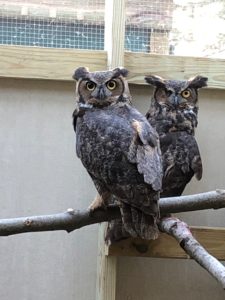 Great horned owls are the largest of the year-round owl species that live in southwest Michigan. Their habitat in the wild includes forest edges, swamps, parks, suburbs, woods, deserts and even tropical rainforests. They are a nocturnal bird of prey and eat many different prey items including mainly small mammals and birds but also reptiles, insects, invertebrate, amphibians and even carrion.
Great horned owls are the largest of the year-round owl species that live in southwest Michigan. Their habitat in the wild includes forest edges, swamps, parks, suburbs, woods, deserts and even tropical rainforests. They are a nocturnal bird of prey and eat many different prey items including mainly small mammals and birds but also reptiles, insects, invertebrate, amphibians and even carrion.
Sometimes they can be seen hunting during the day, but they are usually heard most often than seen. Great Horned Owls advertise their territories with deep, soft hoots with a stuttering rhythm: hoo-h’HOO-hoo-hoo.
While great horned owls can be found all across the United States, the species still faces many threats. Automobile and building collisions and entrapment claim lives of great horned owls, as well as rodent and other toxic poisonings, and viruses and other pathogens.
Sarett’s has one resident great-horned owls named Pops. He suffered trauma from an accident (mostly likely a car accident) that left him unable to be released to the wild. After time spent with a wildlife rehabilitator and joined Sarett’s education animal team in the end of 2017.
 Pops spent time while in rehabilitation fostering great horned owl chicks that were orphaned, and where he got his name Pops. He has a wing injury that left him unable to be released, but he was a great Dad to the chicks who were released back to the wild.
Pops spent time while in rehabilitation fostering great horned owl chicks that were orphaned, and where he got his name Pops. He has a wing injury that left him unable to be released, but he was a great Dad to the chicks who were released back to the wild.
Pops is not on public display, but visits the main Nature Center building for programs with the naturalists and teach the public about their amazing species! Ask at the Nature Center for future bird program dates or to donate to help with the care of Pops.
Life Span: Average 10-20 years in the wild, more in captivity, oldest age recorded in the wild was 28
Size: 39.8 in – 57.1 in. wingspan, 18.1 in. – 24.8 in. tall
Food Habits: Carnivore





